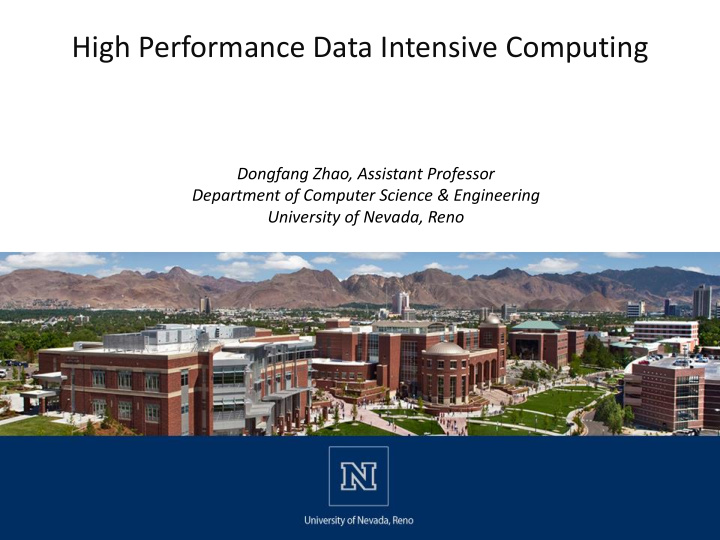



High Performance Data Intensive Computing Dongfang Zhao, Assistant Professor Department of Computer Science & Engineering University of Nevada, Reno
Who am I • 2017 – , Assistant Professor, University of Nevada, Reno • 2016, Postdoctoral Fellow, University of Washington, Seattle • 2015, PhD in Computer Science, Illinois Institute of Technology, Chicago • 2015, Summer Intern, IBM Research – Almaden, San Jose, CA • 2009-2011, Software Engineer, Epic Systems, Madison, WI • 2008, MS in Computer Science, Emory University, Atlanta, GA • 2005, MS in Statistics, Katholieke Universiteit Leuven, Belgium
Outline • Past Work – 2005-2008: Machine Intelligence, Computer Vision – 2012-2015: High Performance Computing, Distributed Systems – 2015-2016: Big Data Systems, Database Systems • Current Status – Personnel – Facilities • Future Research Directions – Distributed Memory Management for Big Data Systems – Locality-aware Resource Management in Virtualized Computing – High Performance Database Systems
Past Work: 2005-2008 • Incremental Dimensionality Reduction • E.g., published at IEEE Transactions on Pattern Analysis and Machine Intelligence (PAMI)
Past Work: 2012-2015 • High Performance Computing • E.g., published at IEEE Transactions on Parallel and Distributed Systems (TPDS)
Past Work: 2015-2016 • Big Data Systems • E.g., published at Very Large Database Systems (VLDB)
Current Status: Personnel • Currently at Nevada: – 1 PhD student starting Fall 2017 – 1 master student starting Fall 2017 – Collaborating closely with Prof. Dr. Feng Yan working on Data Mining and Performance Modelling. He used to publish at KDD, SIGMETRICS, Supercomputing, CLOUD, NOMS, etc. • Plan: – By Fall 2018, the lab will recruit: two more PhD students, two more master students
Current Status: Facilities • Nevada’s HPC cluster – 56 compute nodes: PowerEdge C6320 • 1792 cores • 128 (or 192?) GB RAM per node – 11 GPU Nodes: PowerEdge C4130 each with 4xP100 with NVLink • 352 cores • 44 P100 GPUs • Our lab’s 10 -node GPU cluster, each node has – 12 CPU cores – 4 GeForce GTX 1080 cards – 64 GB RAM
Future Directions • Distributed Memory Management for Big Data Systems – Motivation: Modern big data systems do not have a coordinated way to manage memory • Users are asked to specify the memory allocation • Local OS takes the responsibility – Objective • A middleware to automatically manipulate memory for big data systems • The middleware oversees the overall memory status rather than optimizing the local usage • Users should be able to plug in ad-hoc strategy for the underlying memory management
Future Directions • Locality-aware Resource Management in Virtualized Computing – Extension of my intern work in Summer 2015 – Motivation: Load balance is sometimes overemphasized – Objective: improve data locality for virtualized computation
Future Directions • High Performance Distributed Databases – Motivation: for some reason, HPC’s dominant storage solution is file system – Objective: building a high-performance distributed database system atop existing parallel/distributed file systems that will support performant: • Queries expressed in SQL • Data load, transform, extract, etc. – Challenges • Performance bottleneck: from network to what? • How to leverage GPUs, InfiniBand, MPI, etc. for database workloads? • …
Thanks! Dongfang Zhao dzhao@unr.edu
Recommend
More recommend